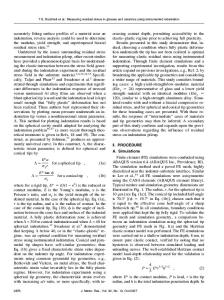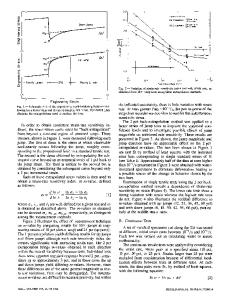Rate-change instrumented indentation for measuring strain rate sensitivity
- PDF / 1,530,165 Bytes
- 5 Pages / 584.957 x 782.986 pts Page_size
- 29 Downloads / 476 Views
A rate-change instrumented indentation method is introduced to experimentally characterize the strain rate sensitivity of high strength materials, such as metallic glasses and nanocrystalline metals, which generally possess low rate sensitivity at room temperature. This technique has been validated herein, via self-consistency between rate jump and rate drop measurements, as a viable way to characterize rate dependent deformation behavior and thereby the underlying micromechanisms of plastic flow. I. INTRODUCTION
Strain rate sensitivity (SRS), which is defined as m ¼ @lnsf =@ln_e to reflect the relationship between the flow stress (sf) and the applied strain rate (_e), is an important dynamic parameter in plastic deformation of crystalline metals/alloys1 and in dynamics and rheology of metallic glasses.2–6 Traditionally, the SRS of crystalline metals and alloys is measured by making strain rate changes in the course of deformation during uniaxial tension or compression, that is, a rate jump test.7 However, for high strength materials, such as bulk metallic glasses (BMGs) and nanocrystalline metals, they generally have low rate sensitivity at room temperature. The measurements of SRS by these traditional experiments are difficult and imprecise as the “true” rate difference in strength is remarkably small, which is often comparable to or even overwhelmed by experimental errors arising from sample surface flaws, casting defects, and insufficient resolution in load/deformation measurements.8 As a result, conventional macroscopic mechanical testing or even the microcompression method9,10 is often phased out as a successful means for accurate characterization of the low rate dependence of the yield/flow stresses. Recently, instrumented indentation has been widely used to measure the SRS of strength/hardness of BMGs and nanometals, in which the SRS is typically determined from hardness measurements on discrete indentations at a variety of loading rates.11–14 The advantages of instrumented indentation over other techniques lie in the precise load/displacement measurements with a nanoscale resolution and nearly defect-free deformation volume. Nonetheless, this metrology is also prone to artifacts induced by factors such as test-to-test differences in maximum load/displacement and starting microstructure in the deformation zone at a)
Address all correspondence to this author. e-mail: [email protected] DOI: 10.1557/JMR.2009.0168
1466
http://journals.cambridge.org
J. Mater. Res., Vol. 24, No. 4, Apr 2009 Downloaded: 14 Mar 2015
discrete indentation sites, surface roughness, and varied elastic deformation upon change in strain/loading rates.6,13 In this article, a rate-change instrumented indentation method is proposed to eliminate these artifacts in SRS measurements while retaining the advantages of nanoindentation for precisely determining low SRS of strength of materials at room temperature. II. EXPERIMENTAL
As examples, the strain rate sensitivities of Ni53Nb20 Ti10Zr8Co6Cu3 BMG as well as nanocrystalline nicke
Data Loading...











